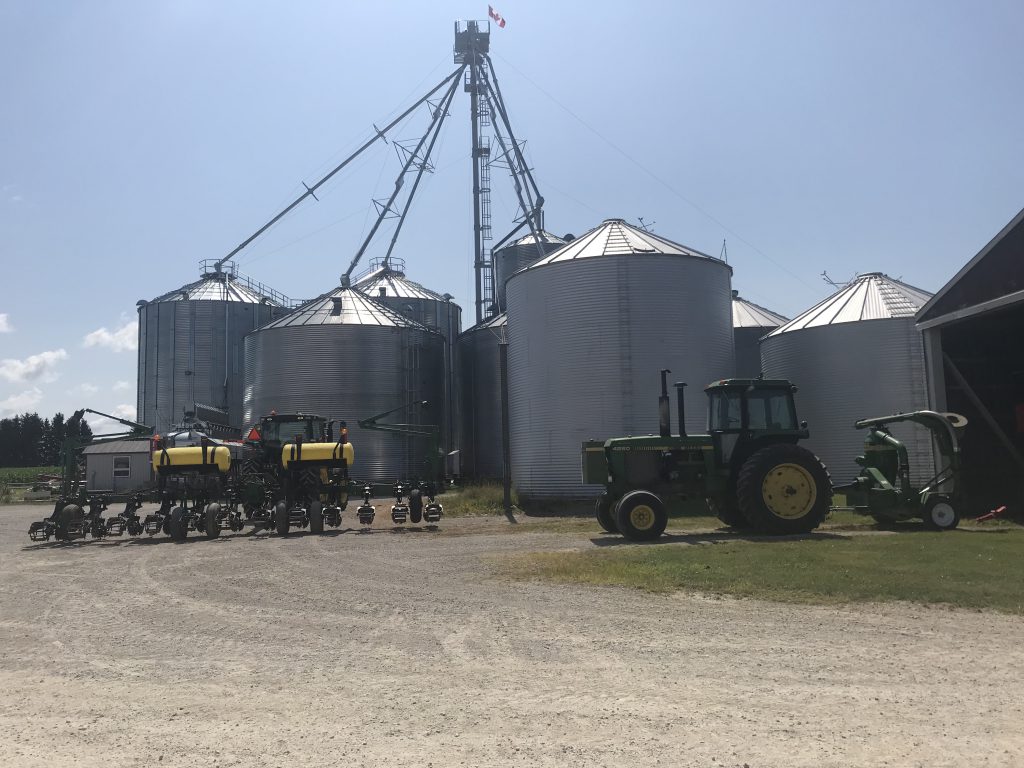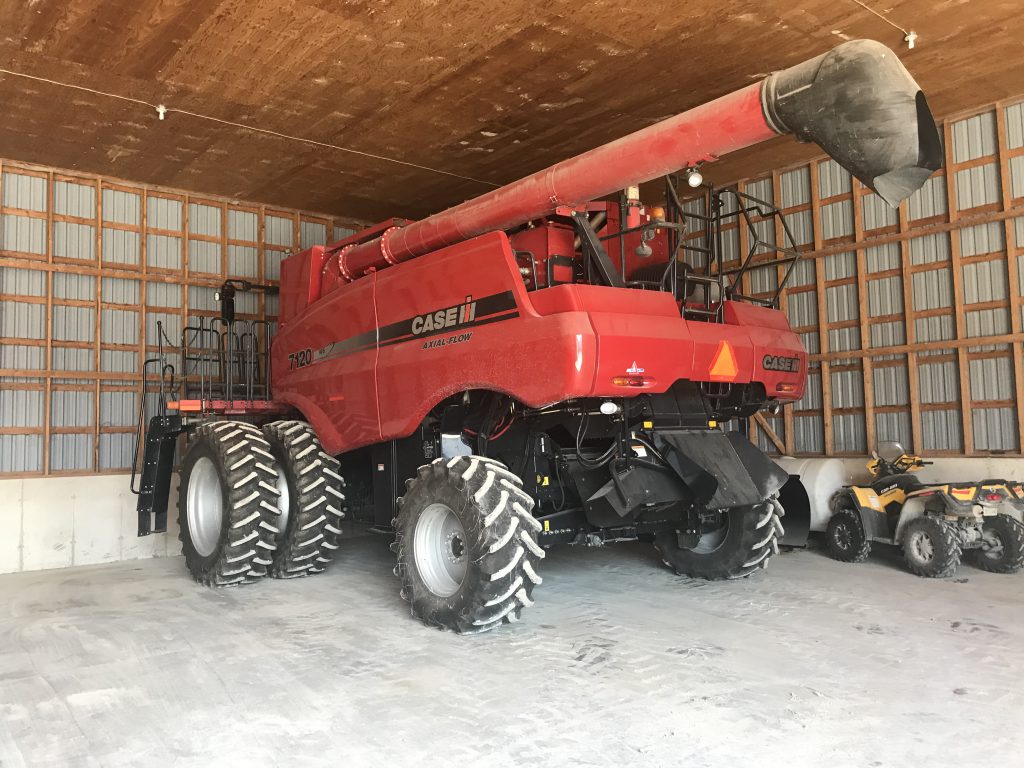In July, AgriLand took an insightful trip with the Grain Farmers of Ontario, Canada. Last year, Ireland was the biggest buyer of exported Canadian maize and the trip brought us into farms which produce these crops.
Shepherd’s Creek Farm was one farm which we got to explore and it didn’t disappoint. It’s certainly worth a look back.
“I built this drill.” That was one of the first things that Mark Brock said when he greeted a group of EU journalists in Ontario, Canada, last July.
From then on he had us enthralled. He’s a farmer who’s passionate about crops, technology and sustainability – economics, environment and people.
Key to sustainability is documenting the work being done on Shepherd’s Creek Farm, after all you can’t say something is sustainable if there is no proof and you can’t improve things if you don’t record – ‘you can’t manage what you don’t measure’.
Mark’s wife Sandi threw in that phrase as she came from the sheep unit on the farm. The pair run a grain and livestock operation across 1,800ac near Staffa in Ontario, Canada. Sandi manages a flock of 450 ewes, while Mark looks after the corn, soybeans and winter wheat, but forces join together at peak times for the given enterprises.
As Mark says himself, they have always been progressive on the farm. His father was one of the first to buy a no-till drill in the late 1980s. Later they planted no-till soybeans into corn stalks, despite crazy looks from his neighbours.
The motto on the farm is not centred around yield per acre, but the overall return as a farm. In recent years, technology has played an important role for the Brocks and they also hope it can help to face societal challenges which are becoming more and more common.
“What’s our role in society in terms of environmental goods and services? We always say that we’re sustainable or we’re doing good things, but I think we’re now at a point where we’re actually trying to document it more. So when society says what are you doing? We can say we’re doing this, this and this.
“I have an iPad in my hand and behind me is a sprayer that we use that has a file of technology on it and every time that sprayer goes through a field it’s documented on my iPad.”
An on-farm weather station allows spraying decisions to be made and recorded. Drift and humidity are monitored and the correct time to spray is decided.
The nice part about it now is that this happens in the background through the process.
“Anytime we start a tractor or a combine we have a monitor that records everything that we do.
Focus on soil health
“I think our goal on our farm right now is to focus more on soil health and soil quality. We’ve moved to strip till, where we’re just working a small zone of the soil that we want to plant the crop in.”
Mark explained: “Our climate here is very good. Our shoulder seasons can be a little cooler, so for us to take advantage of the growing season as much as we can, we like to have a warmer zone for the corn plants to go into so that they can get started and going well.
“A healthy start for the plant really makes it easier to manage. We don’t have to use as many products for stress because it’s had a good start.”
Mark added that they are flexible in their farming system and they will use shallow-tillage when needed. Up to recently he didn’t rule out the plough. Conditions are challenging on the Brocks’ land. It carries excess water in the spring time and can quickly run into a deficit.
There was always a plough in the shed; I sold it. With strip-till we can carry the combine a lot better in the fall.
“So even though we might have some challenges in a wet fall, because of our soil structure we’re able to carry the combine a lot better,” he added.
Crop rotation
The rotation on the farm is corn, soybeans and winter wheat. Three-quarters of the farm is in corn and soybeans, while the remainder is in winter wheat. Mark is trying to move this to one-third of the land for each crop.
However, he noted: “The complexity of farming and weather makes it a little bit of a challenge.”
Following the winter wheat a cover crop is planted. Mark plants a mixed species cover which often includes: sunflowers; buckwheat; oats; and clovers to name a few.
Farmyard manure is also available from the sheep enterprise, as well as poultry manure from another family business.
Mark has noticed a significant increase in the area being planted to cover crops in recent years.
“Now, when you drive through the country, you see a lot more cover crops and some of them might just be a simple oat cover crop.
We’re doing a bit more of the multi-species stuff, but you don’t have to make it complicated.
“We try and encourage people to slowly get into a new system and see what works for you. We’re very adamant that our system isn’t something that you can cut and paste onto another farm.
You have to understand your soil; understand the dynamics of your farm operation and create a system that works for you.
High-value crops and risk
The Brocks also grow navy and black turtle beans. These edible beans are high-value crops and help to increase income.
“Our land costs are fairly high so we’re looking at some crops with a higher rate of return, but we also have to manage risk because they’re a little trickier to grow.”
When establishing this crop, Mark usually tills a strip in the fall and plants the beans into that stale strip in the spring time.
Trying new things and leading the way
Mark and Sandi are adamant that some farmers have to lead the way in order for farming practices to change.
“We tell our story – warts and all. If we have a failure we’re very open about our failure and we try to collaborate with others to see how do we fix this for next year. A lot of times we can get through okay, but we learn something every year.”
One thing that Mark is very pleased with is the use of fungicide maps. Using satellite imagery, fungicide maps were developed – based on NDVI. These maps were then “ground truthed” as Mark says. Using individual nozzle control the sprayer then turns itself on and off where fungicide is and isn’t needed.
This adds to the sustainability level of the farm.
People talk about sustainability – it’s environment, economics and people; it’s three pillars. We can never forget the economics of farming.
“We try to do that within reason and with scope when we make decisions about the environmental impact. If we have to spray an insecticide we weigh that decision very heavily on our economic return. We’ll spray when we have to spray; we won’t when we don’t.”
Other changes on the farm have included a change in tyres on the chaser bins, which now almost look flat when full. Mark can control the grain driers from the combine via smart phone. All these things make the farm sustainable across all three pillars.
Capitalised
Talking about these technologies it is clear that a lot of money has been invested on the farm. Sandi explained: “We’re pretty capitalised. We invest in ourselves to get away from the farm and to make life easier.”
The day-to-day work can be done by one person. Having said this they do not leave the farm at busy times.
The sheep enterprise has helped with cash-flow on the farm and the Brocks are looking towards a third income stream to further reduce risk.
Sandi added that the lamb cheque is nice for generating cash-flow. Being two hours from Toronto provides an excellent market.
It ended up being more promising than we thought.
“It does not diminish how much work it is and there has been a lot of things we’ve integrated onto the farm to make that work a little bit more efficiently.”
Sandi lambs four times throughout the year and the work load is heavy, but the pair seem to have found a balance. They are measuring and managing, which allows the farm to progress and prosper.







